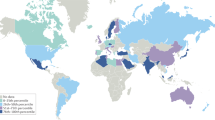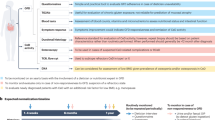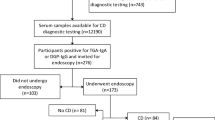Key Points
-
Coeliac disease presents in many different ways at any age
-
All initial testing, except HLA genotyping, should be done whilst patients are on a gluten-containing diet
-
Coeliac-specific serological tests have improved and now rival the accuracy of biopsy results in many circumstances
-
Duodenal biopsies can be avoided in a minority of patients when specific serological, HLA and clinical criteria are met
-
The negative predictive value of HLA genotype risk determination is a useful adjunct to coeliac disease diagnosis, especially in those already on a gluten-free diet
-
Biopsies remain an important part of the diagnosis for coeliac disease in the majority of patients
Abstract
The diagnosis of coeliac disease has advanced in the past decade owing to increased clinical awareness and improved tests. Coeliac disease is now regarded as a common disease presenting at any age with a broad spectrum of symptoms. Previous guidelines on diagnosis relied on the histological analysis of duodenal biopsy samples. However, contemporary antibody analysis is a diagnostic tool with a comparatively high accuracy that has reduced reliance on performing biopsies. Furthermore, determination of HLA-based genetic susceptibility to coeliac disease has become routine. European and North American guidelines utilize symptoms, coeliac antibodies (primarily tissue transglutaminase 2 IgA and endomysial IgA antibodies), HLA determination and histological analysis of biopsy tissue for diagnosis. Some guidelines conclude that the diagnostic accuracy of tissue transglutaminase 2 IgA antibodies is sufficient to omit duodenal biopsies in selected children with very high antibody levels, in the presence of clear symptom response as well as a positive endomysial antibody test and confirmation of genetic susceptibility. This Review discusses if such a strategy is appropriate for children and adults in all populations. The performance characteristics of antibody tests (particularly of the tissue transglutaminase 2 IgA test) including quality control and characterisation of the population in whom testing is performed are also discussed.
This is a preview of subscription content, access via your institution
Access options
Subscribe to this journal
Receive 12 print issues and online access
$209.00 per year
only $17.42 per issue
Buy this article
- Purchase on Springer Link
- Instant access to full article PDF
Prices may be subject to local taxes which are calculated during checkout



Similar content being viewed by others
References
Jabri, B. & Sollid, L. M. Tissue-mediated control of immunopathology in coeliac disease. Nat. Rev. Immunol. 9, 858–870 (2009).
Rewers, M. Epidemiology of celiac disease: what are the prevalence, incidence, and progression of celiac disease? Gastroenterology 128, S47–S51 (2005).
Nistico, L. et al. Concordance, disease progression, and heritability of coeliac disease in Italian twins. Gut 55, 803–808 (2006).
Murray, J. A. et al. HLA DQ gene dosage and risk and severity of celiac disease. Clin. Gastroenterol. Hepatol. 5, 1406–1412 (2007).
Mearin, M. L. et al. HLA-DR phenotypes in Spanish coeliac children: their contribution to the understanding of the genetics of the disease. Gut 24, 532–537 (1983).
Sollid, L. M. et al. Evidence for a primary association of celiac disease to a particular HLA-DQ alpha/beta heterodimer. J. Exp. Med. 169, 345–350 (1989).
Karell, K. et al. HLA types in celiac disease patients not carrying the DQA1*05-DQB1*02 (DQ2) heterodimer: results from the European Genetics Cluster on Celiac Disease. Hum. Immunol. 64, 469–477 (2003).
Hansen, D. et al. Clinical benefit of a gluten-free diet in type 1 diabetic children with screening-detected celiac disease: a population-based screening study with 2 years' follow-up. Diabetes Care 29, 2452–2456 (2006).
Valentino, R. et al. Prevalence of coeliac disease in patients with thyroid autoimmunity. Horm. Res. 51, 124–127 (1999).
Iltanen, S. et al. Celiac disease and markers of celiac disease latency in patients with primary Sjögren's syndrome. Am. J. Gastroenterol. 94, 1042–1046 (1999).
Bonamico, M. et al. Prevalence and clinical picture of celiac disease in Turner syndrome. J. Clin. Endocrinol. Metab. 87, 5495–5498 (2002).
Hill, P. G. & Holmes, G. K. Coeliac disease: a biopsy is not always necessary for diagnosis. Aliment. Pharmacol. Ther. 27, 572–577 (2008).
Hogberg, L. & Stenhammar, L. Celiac disease: Pediatric celiac disease—is a diagnostic biopsy necessary? Nat. Rev. Gastroenterol. Hepatol. 9, 127–128 (2012).
Bottaro, G. et al. Changes in coeliac disease behaviour over the years. Acta Paediatr. 82, 566–568 (1993).
Garampazzi, A. et al. Clinical pattern of celiac disease is still changing. J. Pediatr. Gastroenterol. Nutr. 45, 611–614 (2007).
Ferrara, M., Coppola, L., Coppola, A. & Capozzi, L. Iron deficiency in childhood and adolescence: retrospective review. Hematology 11, 183–186 (2006).
Collin, P., Vilska, S., Heinonen, P. K., Hallstrom, O. & Pikkarainen, P. Infertility and coeliac disease. Gut 39, 382–384 (1996).
Zugna, D., Richiardi, L., Akre, O., Stephansson, O. & Ludvigsson, J. F. A nationwide population-based study to determine whether coeliac disease is associated with infertility. Gut 59, 1471–1475 (2010).
Zugna, D., Richiardi, L., Akre, O., Stephansson, O. & Ludvigsson, J. F. Celiac disease is not a risk factor for infertility in men. Fertil. Steril. 95, 1709–1713 (2011).
Salmi, T. T., Hervonen, K., Kautiainen, H., Collin, P. & Reunala, T. Prevalence and incidence of dermatitis herpetiformis: a 40-year prospective study from Finland. Br. J. Dermatol. 165, 354–359 (2011).
Ivarsson, A. et al. High prevalence of undiagnosed coeliac disease in adults: a Swedish population-based study. J. Intern. Med. 245, 63–68 (1999).
Virta, L. J., Kaukinen, K. & Collin, P. Incidence and prevalence of diagnosed coeliac disease in Finland: results of effective case finding in adults. Scand. J. Gastroenterol. 44, 933–938 (2009).
Rubio-Tapia, A., Ludvigsson, J. F., Brantner, T. L., Murray, J. A. & Everhart, J. E. The prevalence of celiac disease in the United States. Am. J. Gastroenterol. 107, 1538–1544 (2012).
Marsh, M. N. Grains of truth: evolutionary changes in small intestinal mucosa in response to environmental antigen challenge. Gut 31, 111–114 (1990).
Ravelli, A. et al. How patchy is patchy villous atrophy?: distribution pattern of histological lesions in the duodenum of children with celiac disease. Am. J. Gastroenterol. 105, 2103–2110 (2010).
Vogelsang, H., Hanel, S., Steiner, B. & Oberhuber, G. Diagnostic duodenal bulb biopsy in celiac disease. Endoscopy 33, 336–340 (2001).
Rubio-Tapia, A., Hill, I. D., Kelly, C. P., Calderwood, A. H. & Murray, J. A. ACG clinical guidelines: diagnosis and management of celiac disease. Am. J. Gastroenterol. 108, 656–676 (2013).
Hudacko, R., Kathy Zhou, X. & Yantiss, R. K. Immunohistochemical stains for CD3 and CD8 do not improve detection of gluten-sensitive enteropathy in duodenal biopsies. Mod. Pathol. 26, 1241–1245 (2013).
Husby, S. et al. European Society for Pediatric Gastroenterology, Hepatology, and Nutrition guidelines for the diagnosis of coeliac disease. J. Pediatr. Gastroenterol. Nutr. 54, 136–160 (2012).
Revised criteria for diagnosis of coeliac disease. Report of Working Group of European Society of Paediatric Gastroenterology and Nutrition. Arch. Dis. Child. 65, 909–911 (1990).
Oberhuber, G., Granditsch, G. & Vogelsang, H. The histopathology of coeliac disease: time for a standardized report scheme for pathologists. Eur. J. Gastroenterol. Hepatol. 11, 1185–1194 (1999).
McNeish, A. S. et al. The diagnosis of coeliac disease. A commentary on the current practices of members of the European Society for Paediatric Gastroenterology and Nutrition (ESPGAN). Arch. Dis. Child. 54, 783–786 (1979).
Pellegrino, S. et al. Redefining the intraepithelial lymphocytes threshold to diagnose gluten sensitivity in patients with architecturally normal duodenal histology. Aliment. Pharmacol. Ther. 33, 697–706 (2011).
Biagi, F. et al. Intraepithelial lymphocytes in the villous tip: do they indicate potential coeliac disease? J. Clin. Pathol. 57, 835–839 (2004).
Walker, M. M. et al. Detection of celiac disease and lymphocytic enteropathy by parallel serology and histopathology in a population-based study. Gastroenterology 139, 112–119 (2010).
Spencer, J., Isaacson, P. G., MacDonald, T. T., Thomas, A. J. & Walker-Smith, J. A. Gamma/delta T cells and the diagnosis of coeliac disease. Clin. Exp. Immunol. 85, 109–113 (1991).
Kaukinen, K. et al. Small-bowel mucosal transglutaminase 2-specific IgA deposits in coeliac disease without villous atrophy: a prospective and randomized clinical study. Scand. J. Gastroenterol. 40, 564–572 (2005).
Rathsman, S. et al. Elution of antitransglutaminase antibodies from duodenal biopsies: a novel approach in the diagnosis of celiac disease. APMIS 120, 666–674 (2012).
Tosco, A. et al. Immunoglobulin A anti-tissue transglutaminase antibody deposits in the small intestinal mucosa of children with no villous atrophy. J. Pediatr. Gastroenterol. Nutr. 47, 293–298 (2008).
Weile, B., Hansen, B. F., Hagerstrand, I., Hansen, J. P. & Krasilnikoff, P. A. Interobserver variation in diagnosing coeliac disease. A joint study by Danish and Swedish pathologists. APMIS 108, 380–384 (2000).
Corazza, G. R. et al. Comparison of the interobserver reproducibility with different histologic criteria used in celiac disease. Clin. Gastroenterol. Hepatol. 5, 838–843 (2007).
Mubarak, A., Nikkels, P., Houwen, R. & ten Kate, F. Reproducibility of the histological diagnosis of celiac disease. Scand. J. Gastroenterol. 46, 1065–1073 (2011).
Rubio-Tapia, A. et al. Severe spruelike enteropathy associated with olmesartan. Mayo Clin. Proc. 87, 732–738 (2012).
Seah, P. P., Fry, L., Rossiter, M. A., Hoffbrand, A. V. & Holborow, E. J. Anti-reticulin antibodies in childhood coeliac disease. Lancet 2, 681–682 (1971).
Harewood, G. C. & Murray, J. A. Diagnostic approach to a patient with suspected celiac disease: a cost analysis. Dig. Dis. Sci. 46, 2510–2514 (2001).
Rostom, A., Murray, J. A. & Kagnoff, M. F. American Gastroenterological Association (AGA) Institute technical review on the diagnosis and management of celiac disease. Gastroenterology 131, 1981–2002 (2006).
Dieterich, W. et al. Identification of tissue transglutaminase as the autoantigen of celiac disease. Nat. Med. 3, 797–801 (1997).
Maki, M. et al. Prevalence of Celiac disease among children in Finland. N. Engl. J. Med. 348, 2517–2524 (2003).
Simell, S. et al. Fate of five celiac disease-associated antibodies during normal diet in genetically at-risk children observed from birth in a natural history study. Am. J. Gastroenterol. 102, 2026–2035 (2007).
Salardi, S. et al. Prevalence of celiac disease in children with type 1 diabetes mellitus increased in the mid-1990 s: an 18-year longitudinal study based on anti-endomysial antibodies. J. Pediatr. Gastroenterol. Nutr. 46, 612–614 (2008).
Kurppa, K., Collin, P., Lindfors, K., Maki, M. & Kaukinen, K. Spontaneous negative seroconversion of endomysial antibodies does not exclude subsequent celiac disease. J. Pediatr. Gastroenterol. Nutr. 53, 576–579 (2011).
Li, M. et al. A report on the International Transglutaminase Autoantibody Workshop for Celiac Disease. Am. J. Gastroenterol. 104, 154–163 (2009).
Kurppa, K. et al. Endomysial antibodies predict celiac disease irrespective of the titers or clinical presentation. World J. Gastroenterol. 18, 2511–2516 (2012).
Giersiepen, K. et al. Accuracy of diagnostic antibody tests for coeliac disease in children: summary of an evidence report. J. Pediatr. Gastroenterol. Nutr. 54, 229–241 (2012).
Toftedal, P. et al. Positive predictive value of serological diagnostic measures in celiac disease. Clin. Chem. Lab. Med. 48, 685–691 (2010).
Kurppa, K. et al. Utility of the new ESPGHAN criteria for the diagnosis of celiac disease in at-risk groups. J. Pediatr. Gastroenterol. Nutr. 54, 387–391 (2012).
Vermeersch, P. et al. Defining thresholds of antibody levels improves diagnosis of celiac disease. Clin. Gastroenterol. Hepatol. 11, 398–403; quiz e332 (2013).
Egner, W., Shrimpton, A., Sargur, R., Patel, D. & Swallow, K. ESPGHAN guidance on coeliac disease 2012: multiples of ULN for decision making do not harmonise assay performance across centres. J. Pediatr. Gastroenterol. Nutr. 55, 733–735 (2012).
Swallow, K. et al. Quality not quantity for transglutaminase antibody 2: the performance of an endomysial and tissue transglutaminase test in screening coeliac disease remains stable over time. Clin. Exp. Immunol. 171, 100–106 (2013).
Raivio, T. et al. Comparison of a novel whole blood transglutaminase-based ELISA with a whole blood rapid antibody test and established conventional serological celiac disease assays. J. Pediatr. Gastroenterol. Nutr. 47, 562–567 (2008).
Dahlbom, I. et al. Prediction of clinical and mucosal severity of coeliac disease and dermatitis herpetiformis by quantification of IgA/IgG serum antibodies to tissue transglutaminase. J. Pediatr. Gastroenterol. Nutr. 50, 140–146 (2010).
Chow, M. A., Lebwohl, B., Reilly, N. R. & Green, P. H. Immunoglobulin A deficiency in celiac disease. J. Clin. Gastroenterol. 46, 850–854 (2012).
Prause, C. et al. Antibodies against deamidated gliadin as new and accurate biomarkers of childhood coeliac disease. J. Pediatr. Gastroenterol. Nutr. 49, 52–58 (2009).
Amarri, S. et al. Antibodies to deamidated gliadin peptides: an accurate predictor of coeliac disease in infancy. J. Clin. Immunol. 33, 1027–1030 (2013).
Villalta, D. et al. IgG antibodies against deamidated gliadin peptides for diagnosis of celiac disease in patients with IgA deficiency. Clin. Chem. 56, 464–468 (2010).
Bienvenu, F. et al. Evaluation of a point-of-care test based on deamidated gliadin peptides for celiac disease screening in a large pediatric population. Eur. J. Gastroenterol. Hepatol. 24, 1418–1423 (2012).
Korponay-Szabo, I. R. et al. Population screening for coeliac disease in primary care by district nurses using a rapid antibody test: diagnostic accuracy and feasibility study. BMJ 335, 1244–1247 (2007).
Margaritte-Jeannin, P. et al. HLA-DQ relative risks for coeliac disease in European populations: a study of the European Genetics Cluster on Coeliac Disease. Tissue Antigens 63, 562–567 (2004).
Liu, E. et al. Risk of pediatric celiac disease according to HLA haplotype and country. N. Engl. J. Med. 371, 42–49 (2014).
Madsen, M. et al. HLA-B, -DR haplotype frequencies and gametic association in 1,204 unrelated Danes. Tissue Antigens 18, 276–279 (1981).
Hadithi, M. et al. Accuracy of serologic tests and HLA-DQ typing for diagnosing celiac disease. Ann. Intern. Med. 147, 294–302 (2007).
Bai, J. C. et al. World Gastroenterology Organisation global guidelines on celiac disease. J. Clin. Gastroenterol. 47, 121–126 (2013).
Ludvigsson, J. F. et al. The Oslo definitions for coeliac disease and related terms. Gut 62, 43–52 (2013).
Junker, Y. et al. Wheat amylase trypsin inhibitors drive intestinal inflammation via activation of Toll-like receptor 4. J. Exp. Med. 209, 2395–2408 (2012).
Biesiekierski, J. R. et al. No effects of gluten in patients with self-reported non-celiac gluten sensitivity after dietary reduction of fermentable, poorly absorbed, short-chain carbohydrates. Gastroenterology 145, 320–328 (2013).
Di Niro, R. et al. High abundance of plasma cells secreting transglutaminase 2-specific IgA autoantibodies with limited somatic hypermutation in celiac disease intestinal lesions. Nat. Med. 18, 441–445 (2012).
Iversen, R. et al. Transglutaminase 2-specific autoantibodies in celiac disease target clustered, N-terminal epitopes not displayed on the surface of cells. J. Immunol. 190, 5981–5991 (2013).
Simon-Vecsei, Z. et al. A single conformational transglutaminase 2 epitope contributed by three domains is critical for celiac antibody binding and effects. Proc. Natl Acad. Sci. USA 109, 431–436 (2012).
Spatola, B. N., Murray, J. A., Kagnoff, M., Kaukinen, K. & Daugherty, P. S. Antibody repertoire profiling using bacterial display identifies reactivity signatures of celiac disease. Anal. Chem. 85, 1215–1222 (2013).
Dubois, P. C. et al. Multiple common variants for celiac disease influencing immune gene expression. Nat. Genet. 42, 295–302 (2010).
Koskinen, L. L. et al. Association study of the IL18RAP locus in three European populations with coeliac disease. Hum. Mol. Genet. 18, 1148–1155 (2009).
Romanos, J. et al. Analysis of HLA and non-HLA alleles can identify individuals at high risk for celiac disease. Gastroenterology 137, 834–840. e1–e3 (2009).
Trynka, G. et al. Dense genotyping identifies and localizes multiple common and rare variant association signals in celiac disease. Nat. Genet. 43, 1193–1201 (2011).
Cotsapas, C. et al. Pervasive sharing of genetic effects in autoimmune disease. PLoS Genet. 7, e1002254 (2011).
Romanos, J. et al. Improving coeliac disease risk prediction by testing non-HLA variants additional to HLA variants. Gut 63, 415–422 (2014).
Auricchio, R. et al. Potential celiac children: 9 years follow-up on a gluten-containing diet. A long follow-up of potential celiac children. Am. J. Gastroenterol. 109, 913–921 (2014).
Cash, B. D. et al. The prevalence of celiac disease among patients with nonconstipated irritable bowel syndrome is similar to controls. Gastroenterology 141, 1187–1193 (2011).
Sanders, D. S. et al. Association of adult coeliac disease with irritable bowel syndrome: a case-control study in patients fulfilling ROME II criteria referred to secondary care. Lancet 358, 1504–1508 (2001).
Spiegel, B. M., DeRosa, V. P., Gralnek, I. M., Wang, V. & Dulai, G. S. Testing for celiac sprue in irritable bowel syndrome with predominant diarrhea: a cost-effectiveness analysis. Gastroenterology 126, 1721–1732 (2004).
Pietzak, M. M., Schofield, T. C., McGinniss, M. J. & Nakamura, R. M. Stratifying risk for celiac disease in a large at-risk United States population by using HLA alleles. Clin. Gastroenterol. Hepatol. 7, 966–971 (2009).
Author information
Authors and Affiliations
Contributions
S.H. and J.A.M. contributed equally to this manuscript.
Corresponding author
Ethics declarations
Competing interests
J.A.M. declares the following support and associations: grant support from Alba Therapeutics, Alvine Pharmaceuticals, Inc. Member of the advisory board for Alvine Pharmaceuticals Inc. and is a consultant for AMAG Pharmaceuticals, Entera Health Inc., Sonomaceuticals LLC, BioLineRx and GlaxoSmithKline. S.H. declares no competing interests.
Rights and permissions
About this article
Cite this article
Husby, S., Murray, J. Diagnosing coeliac disease and the potential for serological markers. Nat Rev Gastroenterol Hepatol 11, 655–663 (2014). https://doi.org/10.1038/nrgastro.2014.162
Published:
Issue Date:
DOI: https://doi.org/10.1038/nrgastro.2014.162
This article is cited by
-
Development of an administrative definition for celiac disease
BMC Research Notes (2019)
-
Genomic prediction of celiac disease targeting HLA-positive individuals
Genome Medicine (2015)



